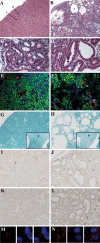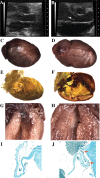Pkd1 transgenic mice: adult model of polycystic kidney disease with extrarenal and renal phenotypes
- PMID: 20053665
- PMCID: PMC4081642
- DOI: 10.1093/hmg/ddp588
Pkd1 transgenic mice: adult model of polycystic kidney disease with extrarenal and renal phenotypes
Abstract
While high levels of Pkd1 expression are detected in tissues of patients with autosomal dominant polycystic kidney disease (ADPKD), it is unclear whether enhanced expression could be a pathogenetic mechanism for this systemic disorder. Three transgenic mouse lines were generated from a Pkd1-BAC modified by introducing a silent tag via homologous recombination to target a sustained wild-type genomic Pkd1 expression within the native tissue and temporal regulation. These mice specifically overexpressed the Pkd1 transgene in extrarenal and renal tissues from approximately 2- to 15-fold over Pkd1 endogenous levels in a copy-dependent manner. All transgenic mice reproducibly developed tubular and glomerular cysts leading to renal insufficiency. Interestingly, Pkd1(TAG) mice also exhibited renal fibrosis and calcium deposits in papilla reminiscent of nephrolithiasis as frequently observed in ADPKD. Similar to human ADPKD, these mice consistently displayed hepatic fibrosis and approximately 15% intrahepatic cysts of the bile ducts affecting females preferentially. Moreover, a significant proportion of mice developed cardiac anomalies with severe left-ventricular hypertrophy, marked aortic arch distention and/or valvular stenosis and calcification that had profound functional impact. Of significance, Pkd1(TAG) mice displayed occasional cerebral lesions with evidence of ruptured and unruptured cerebral aneurysms. This Pkd1(TAG) mouse model demonstrates that overexpression of wild-type Pkd1 can trigger the typical adult renal and extrarenal phenotypes resembling human ADPKD.
Figures







Similar articles
-
Progressive development of polycystic kidney disease in the mouse model expressing Pkd1 extracellular domain.Hum Mol Genet. 2013 Jun 15;22(12):2361-75. doi: 10.1093/hmg/ddt081. Epub 2013 Feb 25. Hum Mol Genet. 2013. PMID: 23439951
-
Overexpression of PKD1 causes polycystic kidney disease.Mol Cell Biol. 2006 Feb;26(4):1538-48. doi: 10.1128/MCB.26.4.1538-1548.2006. Mol Cell Biol. 2006. PMID: 16449663 Free PMC article.
-
Acute kidney injury induces hallmarks of polycystic kidney disease.Am J Physiol Renal Physiol. 2016 Oct 1;311(4):F740-F751. doi: 10.1152/ajprenal.00167.2016. Epub 2016 Aug 3. Am J Physiol Renal Physiol. 2016. PMID: 27488998
-
The genetics and physiology of polycystic kidney disease.Semin Nephrol. 2001 Mar;21(2):107-23. doi: 10.1053/snep.2001.20929. Semin Nephrol. 2001. PMID: 11245774 Review.
-
The master regulators Myc and p53 cellular signaling and functions in polycystic kidney disease.Cell Signal. 2020 Jul;71:109594. doi: 10.1016/j.cellsig.2020.109594. Epub 2020 Mar 4. Cell Signal. 2020. PMID: 32145315 Review.
Cited by
-
Cardiac dysfunction in Pkd1-deficient mice with phenotype rescue by galectin-3 knockout.Kidney Int. 2016 Sep;90(3):580-97. doi: 10.1016/j.kint.2016.04.028. Epub 2016 Jul 27. Kidney Int. 2016. PMID: 27475230 Free PMC article.
-
Cystic kidney disease: the role of Wnt signaling.Trends Mol Med. 2010 Aug;16(8):349-60. doi: 10.1016/j.molmed.2010.05.004. Epub 2010 Jun 22. Trends Mol Med. 2010. PMID: 20576469 Free PMC article. Review.
-
Physiologic mechanisms underlying polycystic kidney disease.Physiol Rev. 2025 Jul 1;105(3):1553-1607. doi: 10.1152/physrev.00018.2024. Epub 2025 Feb 12. Physiol Rev. 2025. PMID: 39938884 Free PMC article. Review.
-
Construction of a transgenic pig model overexpressing polycystic kidney disease 2 (PKD2) gene.Transgenic Res. 2013 Aug;22(4):861-7. doi: 10.1007/s11248-012-9686-z. Epub 2013 Jan 13. Transgenic Res. 2013. PMID: 23315160
-
ADPKD: Prototype of Cardiorenal Syndrome Type 4.Int J Nephrol. 2010 Dec 21;2011:490795. doi: 10.4061/2011/490795. Int J Nephrol. 2010. PMID: 21234092 Free PMC article.
References
-
- Chapman A.B., Rubinstein M.D., Hughes R., Stears J.C., Earnest M.P., Johnson A.M., Gabow P.A., Kaehny W.D. Intracranial aneurysms in autosomal dominant polycystic kidney disease. N. Engl. J. Med. 1992;327:916–920. - PubMed
-
- Wei W., Hackmann K., Xu H., Germino G., Qian F. Characterization of cis-autoproteolysis of polycystin-1, the product of human polycystic kidney disease 1 gene. J. Biol. Chem. 2007;282:21729–21737. - PubMed
Publication types
MeSH terms
Substances
Grants and funding
LinkOut - more resources
Full Text Sources
Other Literature Sources
Molecular Biology Databases

